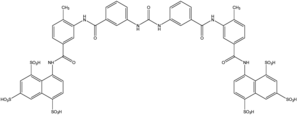Suramin sodium
Suramin is a medicinal drug developed by Oskar Dressel of Bayer, Germany in 1916. It is used for treatment of human sleeping sickness, onchocerciasis and other diseases caused by trypanosomes and worms. more...
The molecular formula of suramin is C51H34N6O23S6. It is a symmetric molecule in the center of which lies urea, NH-CO-NH. Suramin contains 8 benzene rings, 4 of which are fused in paires (naphthalene), 4 amide groups in addition to the one of urea and six sulfonate groups. When given as drug it usually contains six atoms of sodium connected to the sulfonate groups.
Suramin is admistered by a single weekly intravenous injection for six weeks. The dose per injection is 1 g. Most frequent adverse reactions are nausea, vomiting, urticaria and less often renal damage and exfoliative dermatitis.
Read more at Wikipedia.org


